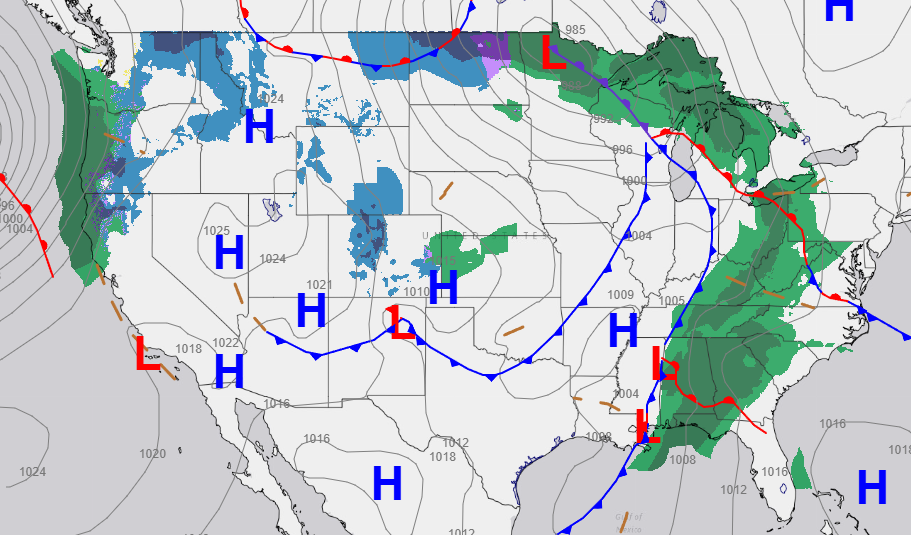It’s All About The Weather
If you don’t love weather or, at the very least, are mildly interested in it, you might have a hard time earning your pilot certificate. Throughout my training I have spent more time studying and analyzing weather than I have spent flying, and, the more I fly, I feel I am spending increasingly more time watching the weather as I realize how important it is to executing a safe flight.
This page could literally be an entire book, so, here are just a few topics that helped me that might be helpful to other beginners.
Shortly after landing on a very wintery day.
Weather Resources
AviationWeather.gov - Primary source for observations and forecasts for most GA pilots.
1800WXBrief.com - Official weather briefings for a flight plan that saves briefing history (proof you checked the weather before your flight).
1-800-WX-BRIEF (1-800-992-7433) - Talk to a live weather briefer. Probably not be practical for every flight, but, you can learn a lot from these highly skilled briefers.
Windy.com - Very cool visual animation of wind conditions. Also has radar, satellite, temperature and other overlays.
Pre-Flight Weather Briefing
It is required that pilots obtain weather information prior to every flight. For me, my pre-flight weather briefing is when my “flight” actually starts. This is when my brain starts shifting into pilot mode and everything else is in my life is put aside until after I am back safely on the ground. This is one of your early opportunities to make decisions that will make your flight smoother and safer. Foremost, is the go/no-go decision which often hinges on a combination of many weather related factors. Once you commit to the flight, this is also your opportunity to start “getting ahead of the plane”. What runway should I expect? Do I need to change my route or destination airport? Should I bring extra water for a hot flight or extra layers for a cold flight? Is there a risk of icing? These are just a few and there are many other questions and answers that come from your briefing, so, a good pilot takes enough time to thoroughly review the day’s weather.
Fly In All Types of Weather
One of the reasons I think everyone should take at least a year to earn their pilot certificate is to have the opportunity to fly in all types of weather with your CFI. I am fortunate to have an amazing CFI who would never shy away from flying in weather as long as it was safe. We flew in rain, snow, wind, sweltering temperatures and also close to 0. The experience gained and lessons learned were invaluable. There is only so much you can learn about weather from studying charts and reports. Flying in different weather and having to make decisions in the air adds a whole new dimension to your training and can actually be quite enjoyable and rewarding. Added bonus, the experience gained may also save you from getting into a situation beyond your ability with catastrophic results.
Pressure Systems
There are many aspects of weather, but, I feel that learning pressure systems is a game changer and was a true aha moment for me that helped me better understand all things weather with one simple memory aid. Think of rising and falling columns of air as drill bits. High pressure is like a plunging drill bit which moves down in a clockwise rotation. Low pressure is the opposite as if backing the drill bit up and out in a counter-clockwise rotation.
With that in mind, you might better understand the prog chart below and visualize how the air masses are moving around. It is also helpful to know that low pressure systems are often associated with volatile weather with precipitation while high pressure systems are generally associated with clear weather.
A Forecast Is Just a Forecast
Aviation weather briefings and observations are probably the absolute best and most accurate weather forecasts available. But, they are still just very educated guesses based on very complicated wind, temperature and humidity factors and often do not fully depict what will actually happen on your particular mission.
The wintery picture at the top of this page was taken shortly after flying some laps in the pattern with my CFI. Visibility was very good the entire flight, but, we could see the wall of weather moving in and stayed out as long as we could do so safely. Mere minutes after landing and securing the plane, the visibility changed dramatically. If we had strayed from the airport and not had our eyes on the weather we could have found ourselves in a very precarious situation.
One of the best ways to ensure the safety of your flight is to be well educated on all aspects of weather. The decisions made on the ground can save your life once in the air.
Navigating spotty showers……safely



